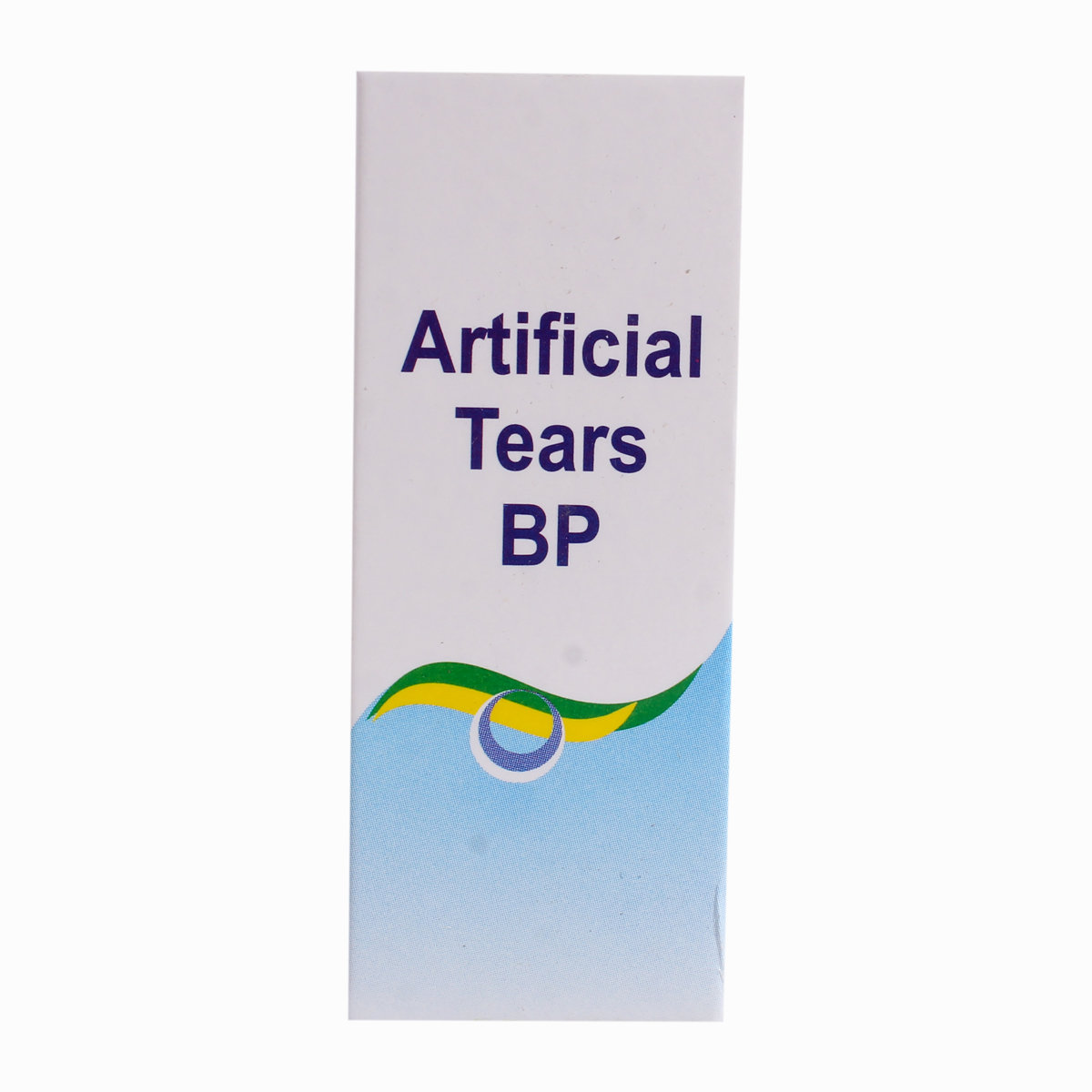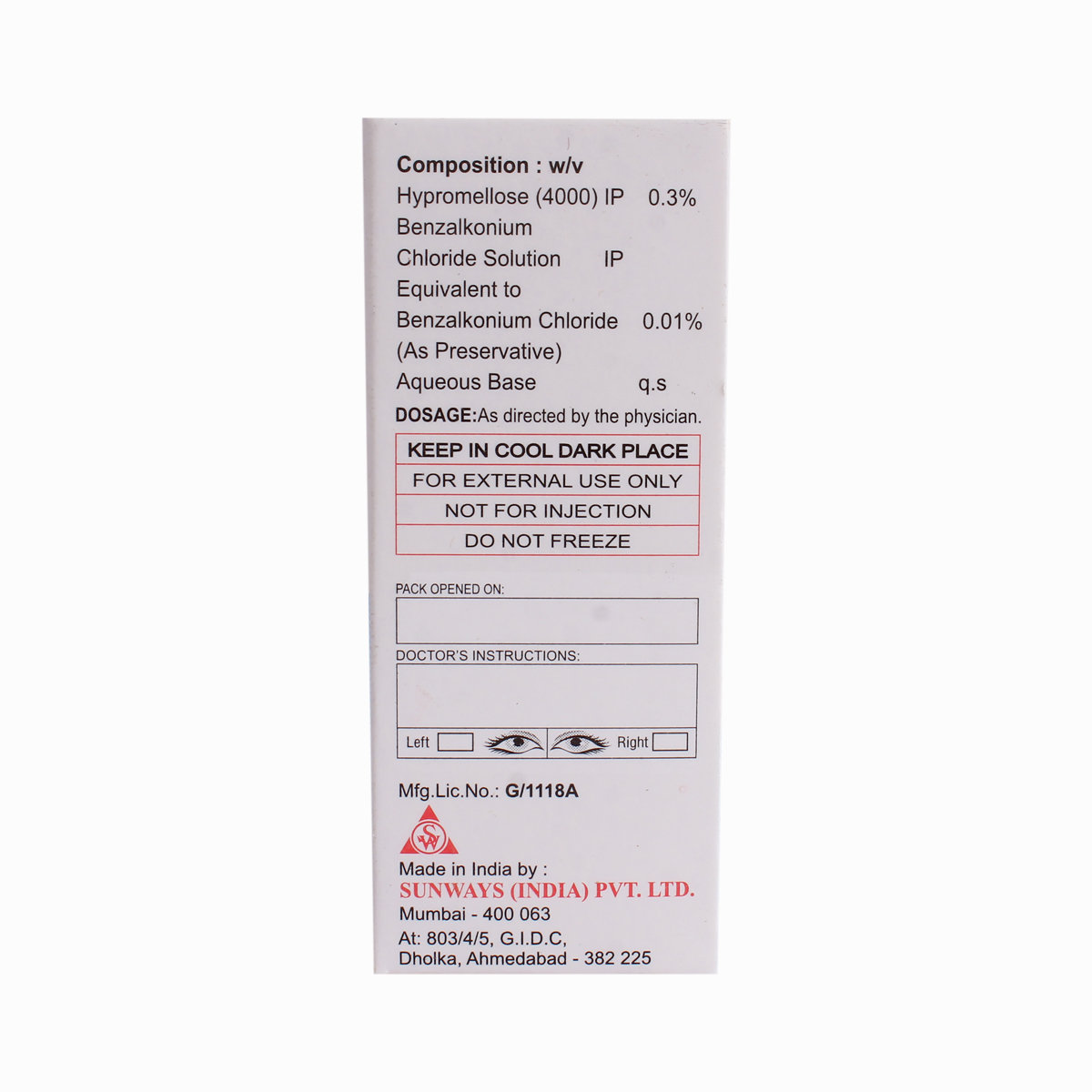Artificial Tears Drops




MRP ₹50.5
(Inclusive of all Taxes)
₹5.0 Cashback (10%)
know your delivery time
Provide Delivery Location
Composition :
Manufacturer/Marketer :
Consume Type :
Expires on or after :
Return Policy :

Secure Payment

Trusted by 8 Crore Indians

Genuine Products
Therapeutic Class
Country of origin
Manufacturer/Marketer address
Disclaimer
Alcohol
Safe if prescribed
Artificial Tears Drops should be taken as advised by your doctor.
Pregnancy
Consult your doctor
Artificial Tears Drops is not recommended for use in pregnant women unless necessary. All the risks and benefits should be discussed with the doctor before administering/receiving this medicine.
Breast Feeding
Consult your doctor
Artificial Tears Drops is not recommended for use in breastfeeding women unless necessary. All the risks and benefits should be discussed with the doctor before administering/receiving this medicine.
Driving
Safe if prescribed
It is not known whether Artificial Tears Drops alters the ability to drive. Do not drive if you experience any symptoms that affect your ability to concentrate and react.
Liver
Consult your doctor
Artificial Tears Drops is probably safe to use in liver diseases. Please consult your doctor before using Artificial Tears Drops.
Kidney
Consult your doctor
Artificial Tears Drops is probably safe to use in kidney diseases. Please consult your doctor before using Artificial Tears Drops.
Children
Safe if prescribed
Before taking Artificial Tears Drops to inform your doctor, because your doctor may make dose adjustments.
Reference
- https://www.webmd.com/drugs/2/drug-32846/artificial-tears-hypromellose/details
- https://www.medicines.org.uk/emc/product/457/smpc#COMPOSITION
- https://www.drugs.com/mtm/hypromellose-ophthalmic.html
- https://www.mims.com/india/drug/info/hypromellose?type=full&mtype=generic#dosage
- https://www.rxlist.com/fdb/drugs/168983/lubricant-eye-drops-hypromellose-ophthalmic-eye-drug.htm
About Artificial Tears Drops
Artificial Tears Drops belongs to the class of medicines called 'ophthalmic lubricants' generally used to treat dry eye disease and in eye surgeries. Dry eye disease is a common condition that occurs if you don't produce enough tears or if you produce poor-quality tears. This tear instability leads to inflammation and damage to the eye's surface.
Artificial Tears Drops contains 'Hypromellose'. Artificial Tears Drops works by increasing tear viscosity in the eye. In this way, it provides temporary relief from burning and discomfort.
Eye drops/eye gel is available for external use only. Some minor side effects are blurred vision, eye pain, foreign body sensation in the eyes, eye irritation, and eye redness. If it persists, take the advice of your doctor.
Before using this Artificial Tears Drops, tell your doctor if you are allergic to any one of the medicine components. Do not touch the tip of the eye drops/eye gel container to avoid contamination, and replace the cap tightly after each use. Do not use a solution, which is colour changed, and cloudy in appearance. Use before the expiration date. Do not change or stop the dose of medicine without informing your doctor. Do not drive or use machinery or perform any activity until your vision is clear, as Artificial Tears Drops causes temporary blurred vision.
Uses of Artificial Tears Drops
Medicinal Benefits Mweb
Key Benefits
Artificial Tears Drops contains 'Hypromellose' which belongs to the class of medicines called 'ophthalmic lubricants' generally used to treat dry eye disease. Artificial Tears Drops works by increasing tear viscosity in the eye. In this way, it provides temporary relief from burning and discomfort. Artificial Tears Drops used as a surgical aid during eye surgeries such as cataract extraction, lens implantation, to prevent damage to the cornea, to facilitate the ease of operating, as well as to reduce the risk of postoperative complications
Directions for Use
Side Effects of Artificial Tears Drops
- Blurred vision
- Eye pain
- Foreign body sensation in eyes
- Eye irritation
- Eye redness
Drug Warnings
Before using this Artificial Tears Drops, tell your doctor if you are allergic to any one of the medicine components. Do not touch the tip of the eye drops/eye gel container to avoid contamination, and replace the cap tightly after each use. Do not use a solution which is colour changed and cloudy in appearance. You should take this medicine as prescribed by your doctor.Use before the expiration date. Do not change or stop the dose of medicine without informing your doctor. Do not drive or use machinery or perform any activity until your vision is clear, as Artificial Tears Drops causes temporary blurred vision. Do not use Artificial Tears Drops with contact lenses. If usage of contact lenses is allowed, remove them before administration of the medicine, and you can reinsert the contact lenses 10 to 15 minutes post-administration. Eye injection is administered during eye surgeries, your surgeon will give you appropriate instructions regarding the usage of contact lenses.
Drug-Drug Interactions
Drug-Drug Interactions
Login/Sign Up
Drug-Food Interactions
Drug-Food Interactions
Login/Sign Up
Drug-Diseases Interactions
Drug-Diseases Interactions
Login/Sign Up
Habit Forming
Special Advise
- If you wear contact lenses, remove them before using Artificial Tears Drops.
- Tell your doctor if your eye condition persists or worsens after 3 days.
Diet & Lifestyle Advise
- Take fish in your diet which has omega-3 fatty acids that may counter dry eyes.
- Leafy greens are rich in vitamin C which contributes to eye health.
- Drink more water, it has a big part to play in tear production.
- Avoid air blowing in your eyes
- Take eye breaks during long tasks and keep your computer screen below eye level.
- Stop smoking and avoid drinking alcohol.
- Use eyeglasses when you are going out.

Have a query?
Buy best Ocular products by
Entod Pharmaceuticals Ltd
Ajanta Pharma Ltd
Sunways (India) Pvt Ltd
Sun Pharmaceutical Industries Ltd
Cipla Ltd
Micro Labs Ltd
Allergan Healthcare India Pvt Ltd
Intas Pharmaceuticals Ltd
Raymed Pharmaceuticals Ltd
Nri Vision Care India Ltd
FDC Ltd
Jawa Pharmaceuticals India Pvt Ltd
Indoco Remedies Ltd
Sapient Laboratories Pvt Ltd
Senses Pharmaceuticals Pvt Ltd
Centaur Pharmaceuticals Pvt Ltd
Neomedix Healthcare India Pvt Ltd
Aromed Pharmaceuticals
Optho Remedies Pvt Ltd
Aurolab
Austrak Pvt Ltd
Lupin Ltd
Mankind Pharma Pvt Ltd
Zivira Labs Pvt Ltd
Optho Pharma Pvt Ltd
Synovia Life Sciences Pvt Ltd
Akumentis Healthcare Ltd
Eyekare
His Eyeness Ophthalmics Pvt Ltd
Protech Remedies Pvt Ltd
Runyon Pharmaceutical Pvt Ltd
Alcon Laboratories Inc
Syntho Pharmaceuticals Pvt Ltd
Alembic Pharmaceuticals Ltd
Bell Pharma Pvt Ltd
Klar Sehen Pvt Ltd
Sentiss Pharma Pvt Ltd
Irx Pharmaceuticals Pvt Ltd
Optho Life Sciences Pvt Ltd
Phoenix Remedies Pvt Ltd
Alkem Laboratories Ltd
Doctor Wonder Pvt Ltd
Hicare Pharma
Ipca Laboratories Ltd
Neon Laboratories Ltd
Okulus Drugs India
Pharmtak Ophthalmics (I) Pvt Ltd
Berry & Herbs Pharma Pvt Ltd
Glow Vision Pharmaceuticals
Kaizen Drugs Pvt Ltd
Choroid Laboratories Pvt Ltd
Indiana Opthalamics Pvt Ltd
Optica Pharmaceutical Pvt Ltd
Pharmatak Opthalmics India Pvt Ltd
Samarth Life Sciences Pvt Ltd
Vibgyor Vision Care
Mofon Drugs
Novartis India Ltd
Pharmia Biogenesis Pvt Ltd
Zydus Cadila
Appasamy Ocular Devices Pvt Ltd
Leeford Healthcare Ltd
Medivision Pharma Pvt Ltd
Orbit Life Science Pvt Ltd
X-Med Royal Pharma Pvt Ltd
Zee Laboratories Ltd
Aarma Laboratories
Guerison MS Inc
Laborate Pharmaceuticals India Ltd
Xtas Pharmaceuticals
Accurex Biomedical Pvt Ltd
Blucrab Pharma Pvt Ltd
Does Health Systems Pvt Ltd
Flagship Biotech International Pvt Ltd
Lavue Pharmaceuticals Pvt Ltd
Nutrilis Healthcare Pvt Ltd
Ursa Pharm India Pvt Ltd
Vee Remedies
Vyonics Health Care India Pvt Ltd
Warren Pharmaceuticals Pvt Ltd
Abbott India Ltd
Accvus Pharmaceuticals
Akums Drugs & Pharmaceuticals Ltd
Cadila Healthcare Ltd
Carevision Pharmaceuticals Pvt Ltd
Dey's Medical Stores (Mfg) Ltd
East West Pharma India Pvt Ltd
Eyedea Pharmaceuticals Pvt Ltd
Nimbus Healthcare Pvt Ltd
Ocuris Pharmaceuticals Pvt Ltd
Sherings Pharmaceuticals
Tarks Pharmaceuticals Pvt Ltd
Vcan Biotech
Vision Medilink
Aice Health Care Pvt Ltd
Appasamy Pharmaceuticals Pvt Ltd
Asperia Lifescience Pvt Ltd
Beatum Healthcare Pvt Ltd
East India Pharmaceutical Works Ltd
Grevis Pharmaceutical Pvt Ltd

